Variable stars


![]()
Variable stars
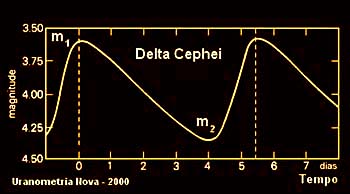
Delta Cephei light curve. Variable Cephei prototype.
Graphic: http://www.uranometrianova.pro.br/
Most stars are of almost constant luminosity. Our own Sun is a good example of one which goes through relatively little variation in brightness (usually about 0.1% over an 11 year solar cycle). Many stars, however, undergo significant variations in luminosity, and these are known as variable stars. There can be intrinsic or extrinsic.
Intrinsic variable stars: stars where the variability is being caused by changes in the physical properties of the stars themselves. This category can be divided into three subgroups.
Pulsating variables, stars whose radius alternately expands and contracts as part of their natural evolutionary ageing processes.
Eruptive variables, stars who experience eruptions on their surfaces like flares or mass ejections.
Cataclysmic or explosive variables, stars that undergo a cataclysmic change in their properties like novae and supernovae.
Extrinsic variable stars: stars where the variability is caused by external properties like rotation or eclipses. There are two main subgroups.
Eclipsing binaries, double stars where, as seen from Earth's vantage point the stars occasionally eclipse one another as they orbit.
Rotating variables, stars whose variability is caused by phenomenon related to their rotation. Examples are stars with extreme "sunspots" which affect the apparent brightness or stars that have fast rotation speeds causing them to become ellipsoidal in shape.
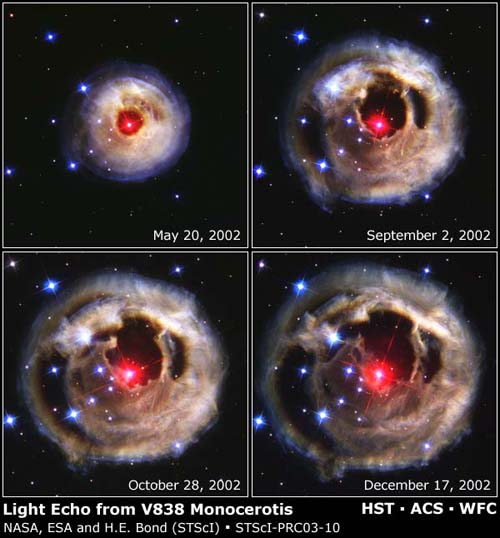
V838 Monocerotis
In January 2002, a dull star in an obscure constellation suddenly became 600,000 times more luminous than our Sun, temporarily making it the brightest star in our Milky Way galaxy. The mysterious star, called V838 Monocerotis, has long since faded back to obscurity. But observations by NASA's Hubble Space Telescope of a phenomenon called a "light echo" around the star have uncovered remarkable new features. These details promise to provide astronomers with a CAT-scan-like probe of the three-dimensional structure of shells of dust surrounding an aging star.
What is a light echo?
It is light from a stellar explosion echoing off dust surrounding the star. V838 Monocerotis produced enough energy in a brief flash to illuminate surrounding dust, like a spelunker taking a flash picture of the walls of an undiscovered cavern. The star presumably ejected the illuminated dust shells in previous outbursts. Light from the latest outburst travels to the dust and then is reflected to Earth. Because of this indirect path, the light arrives at Earth months after light from the star that traveled directly toward Earth.
NASA, ESA and H.E. Bond (STScI)
![]()
Variable stars types
The previous subgroups themselves are further divided into specific types of variable stars that are usually named after their prototype. For example, dwarf novae are designated U Geminorum stars after the first recognized star in the class, U Geminorum.
Variable Stars Intrinsic
Pulsating variables
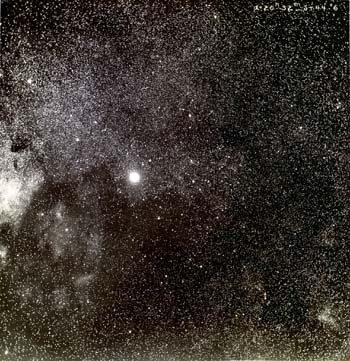
Alpha Cygni (Deneb) is member of a triple system whose main component is a luminous supergiant, pulsating variables ACYG prototype. Picture: http://www.astrogea.org/
ACYG
Variables of the Alpha Cygni type, which are nonradially pulsating supergiants of Bep-AepIa spectral types. The light changes with amplitudes of the order of 0.1 mag often seem irregular, being caused by the superposition of many oscillations with close periods. Cycles from several days to several weeks are observed.
BCEP
Variables of the Beta Cephei type (Beta Cep, Beta CMa), which are pulsating O8-B6 I-V stars with periods of light and radial-velocity variations in the range of 0.1 - 0.6 days and light amplitudes from 0.01 to 0.3 mag in V. The light curves are similar in shape to average radial-velocity curves but lag in phase by a quarter of the period, so that maximum brightness corresponds to
maximum contraction, i.e., to minimum stellar radius. The majority of these stars probably show radial pulsations, but some (V649 Per) display nonradial pulsations; multiperiodicity is characteristic of many of these stars.
CEP
Cepheids. Radially pulsating, high luminosity (classes Ib-II) variables with periods in the range of 1-135 days and amplitudes from several hundredths to 2 mag in V (in the B band, the amplitudes are greater). Spectral type at maximum light is F; at minimum, the types are G-K. The longer the period of light variation,the later is the spectral type. The maximum of the surface-layer expansion velocity almost coinciding with maximum light.
DCEP
These are the classical cepheids, or Delta Cep-type variables. Comparatively young objects that have left the main sequence and evolved into the instability strip of the Hertzsprung-Russell (H-R) diagram, they obey the well-known Cepheid period-luminosity relation and belong to the young disk population. DCEP stars are present in open clusters. They display a certain relation between the shapes of their light curves and their periods.
WV
These are very similar to Cepheids, but belong to Population II and so have a lower metallicity and hence a somewhat different period-luminosity relationship.
DSCT
Variables of the Delta Scuti type. These are pulsating variables of spectral types A0-F5 III-V displaying light amplitudes from 0.003 to 0.9 mag in V (usually several hundredths of a magnitude) and periods from 0.01 to 0.2 days. The shapes of the light curves, periods, and amplitudes usually vary greatly. Radial as well as nonradial pulsations are observed. The variability of some
members of this type appears sporadically and sometimes completely ceases, this being a consequence of strong amplitude modulation with the lower value of the amplitude not exceeding 0.001 mag in some cases. The maximum of the surface layer expansion does not lag behind the maximum light for more than 0.1 periods. DSCT stars are representatives of the galactic disk (flat component) and are phenomenologically close to the SX Phe variables.
DSCTC
Low amplitude group of Delta Sct variables (light amplitude <0.1 mag in V). The majority of this type's representatives are stars of luminosity class V; objects of this subtype generally are representative of the Delta Sct variables in open clusters.
SXP
These stars of spectral type A2 to F5, similar to δ Scuti variables, are found mainly in globular clusters. They exhibit fluctuations in their brightness in the order of 0.7 magnitude or so every 1 to 2 hours.
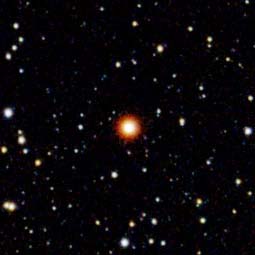
U Omicron Ceti (Mira) is a binary red star. Pulsating variables M prototype. Picture: © T. Credner & S. Kohle, AlltheSky.com
M
Mira (Omicron) Ceti-type variables. These are long-period variable giants with characteristic late-type emission spectra (Me, Ce, Se) and light amplitudes from 2.5 to 11 mag in V. Their periodicity is well pronounced, and the periods lie in the range between 80 and 1000 days. Infrared amplitudes are usually less than in the visible and may be <2.5 mag. For example, in the K band they
usually do not exceed 0.9 mag. If the amplitudes exceed 1 - 1.5 mag , but it is not certain that the true light amplitude exceeds 2.5 mag, the symbol "M" is followed by a colon, or the star is attributed to the semiregular class with a colon following the symbol for that type (SR).
PVT
Stars in this class are helium supergiants with a period of 0.1 - 1 day and an amplitude of 0.1 magnitude on average.
RRC
Variables of the RR Lyrae type, which are radially-pulsating giant A-F stars having amplitudes from 0.2 to 2 mag in V. Cases of variable light-curve shapes as well as variable periods are known. If these changes are periodic, they are called the "Blazhko effect."
Traditionally, RR Lyrae stars are sometimes called short-period Cepheids or cluster-type variables. The majority of these stars belong to the spherical component of the Galaxy; they are present, sometimes in large numbers, in some globular clusters, where they are known as pulsating horizontal-branch stars. Like Cepheids, maximum expansion velocities of surface layers for these stars practically coincide with maximum light.
RVA
Variables of the RV Tauri type. These are radially pulsating supergiants having spectral types F-G at maximum light and K-M at minimum. The light curves are characterized by the presence of double waves with alternating primary and secondary minima that can vary in depth so that primary minima may become secondary and vice versa. The complete light amplitude may reach 3-4 mag in V.
Periods between two adjacent primary minima (usually called formal periods) lie in the range 30-150 days (these are the periods appearing in the Catalogue). Two subtypes, RVA and RVB, are recognized:
RVA
RV Tauri variables that do not vary in mean magnitude (AC Her);
RVB
RV Tauri variables that periodically (with periods from 600 to 1500 days and amplitudes up to 2 mag in V) vary in mean magnitude (DF Cyg, RV Tau).
SR
Semiregular variables, which are giants or supergiants of intermediate and late spectral types showing noticeable periodicity in their light changes, accompanied or sometimes interrupted by various irregularities. Periods lie in the range from 20 to >2000 days, while the shapes of the light curves are rather different and variable, and the amplitudes may be from several hundredths to several magnitudes (usually 1-2 mag in V).
SRA
Semiregular late-type (M, C, S or Me, Ce, Se) giants displaying persistent periodicity and usually small (<2.5 mag in V) light amplitudes (Z Aqr). Amplitudes and light-curve shapes generally vary and periods are in the range of 35-1200 days. Many of these stars differ from Miras only by showing smaller light amplitudes;
SRB
Semiregular late-type (M, C, S or Me, Ce, Se) giants with poorly defined periodicity (mean cycles in the range of 20 to 2300 days) or with alternating intervals of periodic and slow irregular changes, and even with light constancy intervals (RR CrB, AF Cyg). Every star of this type may usually be assigned a certain mean period (cycle), which is the value given in the Catalogue. In a number of cases, the simultaneous presence of two or more periods of light variation is observed;
SRC
Semiregular late-type (M, C, S or Me, Ce, Se) supergiants (Mu Cep) with amplitudes of about 1 mag and periods of light variation from 30 days to several thousand days;
SRD
Semiregular variable giants and supergiants of F, G, or K spectral types, sometimes with emission lines in their spectra. Amplitudes of light variation are in the range from 0.1 to 4 mag, and the range of periods is from 30 to 1100 days (SX Her, SV UMa).
ZZ Ceti star
A white dwarf that is also a pulsating variable and changes in brightness by 0.001 to 0.2 magnitude over a period of 30 seconds to 25 minutes. Non-radial pulsations are involved with multiple periodicities, which result in only slight changes in the star's size but significant fluctuations in temperature.
Eruptive variables
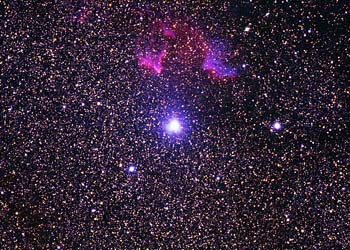
Gamma Cassiopeia is part of a 4 stars system, with 3 visual components and one discovered by spectroscopy. The main component is Eruptive variable GCAS prototype.
Picture: George Greaney http://www.astroimages.com/
UV
Eruptive variables of the UV Ceti type, these are K Ve-M Ve stars sometimes displaying flare activity with amplitudes from several tenths of a magnitude up to 6 mag in V. The amplitude is considerably greater in the ultraviolet spectral region. Maximum light is attained in several seconds or dozens of seconds after the beginning of a flare; the star returns to its normal brightness in several minutes or dozens of minutes.
UGSS
U Geminorum-type variables, quite often called dwarf novae. They are close binary systems consisting of a dwarf or subgiant K-M star that fills the volume of its inner Roche lobe and a white dwarf surrounded by an accretion disk. Orbital periods are in the range 0.05-0.5 days. Usually only small, in some cases rapid, light fluctuations are observed, but from time to time the brightness of a system increases rapidly by several magnitudes and, after an
interval of from several days to a month or more, returns to the original state. Intervals between two consecutive outbursts for a given star may vary greatly, but every star is characterized by a certain mean value of these intervals, i.e., a mean cycle that corresponds to the mean light amplitude. The longer the cycle, the greater the amplitude. These systems are frequently sources of X-ray emission. The spectrum of a system at minimum is continuous, with broad H and He emission lines. At maximum these lines almost disappear or become shallow absorption lines. Some of these systems are eclipsing, possibly indicating that the primary minimum is caused by the eclipse of a hot spot that originates in the accretion disk from the infall of a gaseous stream from the K-M star. According to the characteristics of the light changes, U Gem variables may be subdivided into three types: SS Cyg, SU UMa, and Z Cam.
SS Cyg
SS Cygni-type variables (SS Cyg, U Gem). They increase in brightness by 2-6 mag in V in 1-2 days and in several subsequent days return to their original brightnesses. The values of the cycle are in the range 10 days to several thousand;
UGSU
SU Ursae Majoris-type variables. These are characterized by the presence of two types of outbursts called "normal" and "supermaxima". Normal, short outbursts are similar to those of UGSS stars, while supermaxima are brighter by 2 mag, are more than five times longer (wider), and occur several times less frequently. During supermaxima the light curves show superposed periodic
oscillations (superhumps), their periods being close to the orbital ones and amplitudes being about 0.2-0.3 mag in V. Orbital periods are shorter than 0.1 days; companions are of dM spectral type;
UGZ
Z Camelopardalis-type stars. These also show cyclic outbursts, differing from UGSS variables by the fact that sometimes after an outburst they do not return to the original brightness, but during several cycles retain a magnitude between maximum and minimum. The values of cycles are from 10 to 40 days, while light amplitudes are from 2 to 5 mag in V.
INA
Orion variables. Irregular, eruptive variables connected with bright or dark diffuse nebulae or observed in the regions of these nebulae. Some of them may show cyclic light variations caused by axial rotation. In the Spectrum-Luminosity diagram, they are found in the area of the main sequence and subgiants. They are probably young objects that, during the course of further evolution, will become light-constant stars on the zero-age main sequence (ZAMS). The range of brightness variations may reach several magnitudes. In the case of rapid light variations having been observed (up to 1 mag in 1-10 days), the letter "S" is added to the symbol for the type (INS).
This type may be divided into the following subtypes: INA, INB, INT, IN(YY).
INB
Orion variables of intermediate and late spectral types, F-M or Fe-Me (BH Cep, AH Ori). F-type stars may show Algol-like fadings similar to those of many INA stars; K-M stars may produce flares along with irregular light variations;
INT
Orion variables of the T Tauri type. Stars are assigned to this type on the basis of the following (purely spectroscopic) criteria: spectral types are in the range Fe-Me. The spectra of most typical stars resemble the spectrum of the solar chromosphere. The feature specific to the type is the presence of
the flourescent emission lines Fe II 4046, 4132 A (anomalously intense in the spectra of these stars), emission lines [Si II] and [O I], as well as the absorption line Li I 6707 A. These variables are usually observed only in diffuse nebulae. If it is not apparent that the star is associated with a nebula, the letter "N" in the symbol for the type may be omitted, e.g., IT (RW AUR);
IN(YY)
Some Orion variables (YY Ori) show the presence of absorption components on the redward sides of emission lines, indicating the infall of matter toward the stars' surfaces. In such cases, the symbol for the type may be accompanied by the symbol "YY".
GCAS
Eruptive irregular variables of the Gamma Cas type. These are rapidly rotating B III-IVe stars with mass outflow from their equatorial zones.
The formation of equatorial rings or disks is often accompanied by temporary fading. Light amplitudes may reach 1.5 mag in V.
BE
It becomes more and more clear that, although the majority of Be stars are photometrically variable, not all of them could be properly called GCAS variables. Quite a number of them show small-scale variations not necessarily related to shell events; in some cases the variations are quasi-periodic. By now we are not able to present an elaborated system of classification for Be variables, but we adopt a decision that in the cases when a Be variable cannot be readily described as a GCAS star we give simply BE for the type of variability.
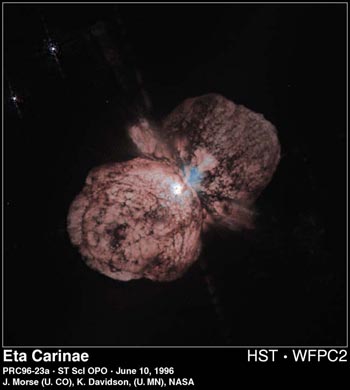
Eta Carinae, SDOR variable type.
Supermassive variable star surrounded by a great emission nebula. It has a mass of over 100 solar masses and luminosity about 4 million times greater than that of the Sun; Maintains its stellar stability throwing enormous amounts of matter to the space, matter that compound the nebula of 200 ly of diameter that surrounds the star. It is SDOR Eruptive variable type and is the main component of a multiple system with up to 15 stars. It is located at 9,000 ly away.
Picture: NASA and Jon Morse (University of Colorado)
SDOR
Variables of the S Doradus type. These are eruptive, high-luminosity Bpec-Fpec stars showing irregular (sometimes cyclic) light changes with amplitudes in the range 1-7 mag in V.
They belong to the brightest blue stars of their parent galaxies. As a rule, these stars are connected with diffuse nebulae and surrounded by expanding envelopes (P Cyg, Eta Car).
RCB
Variables of the R Coronae Borealis type. These are hydrogen-poor,carbon- and helium-rich, high-luminosity stars belonging to the spectral types Bpe-R, which are simultaneously eruptive and pulsating variables. They show slow nonperiodic fadings by 1-9 mag in V lasting from a month or more to several hundred days.
These changes are superposed on cyclic pulsations with amplitudes up to several tenths of a magnitude and periods in the range 30-100 days.
RS Canum Venaticorum
A type of eruptive variable that is also a close binary system and shows modest light variations of up to 0.2 magnitude with a period close to that of the orbital period. Superimposed on these short-period changes are longer-term cycles of chromospheric activity, similar to the solar cycle, that last 1 to 4 years. RS Canum Venaticorum itself (BD +36° 2344, HD 114519) is of spectral type F5 V+K2 IV
WR
Eruptive Wolf-Rayet variables. Stars with broad emission features of He I and He II as well as C II-C IV, O II-O IV, and N III-N V. They display irregular light changes with amplitudes up to 0.1 mag in V, which are probably caused by physical processes, in particular, by nonstable mass outflow from their atmospheres.
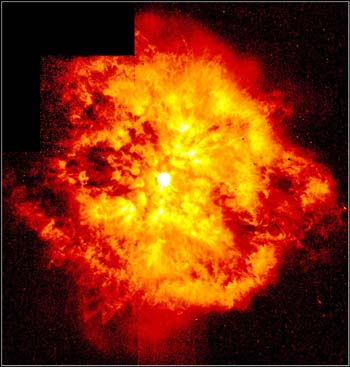
WR124
Nebula surrounding the Wolf-Rayet star WR124 in the constellation Sagittarius. Picture: Yves Grosdidier (University of Montreal and Observatoire de Strasbourg), Anthony Moffat (Universitie de Montreal), Gilles Joncas (Universite Laval), Agnes Acker (Observatoire de Strasbourg)
Nasa-Hubble- ESA
Extrinsic variables
Eclipsing variable
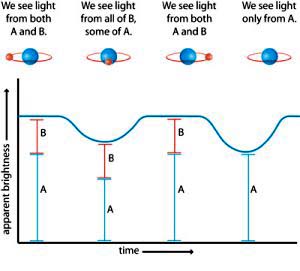
Diagram showing the mechanics of eclipses in a binary system, the cause of the variability of this type of system.
Diagram from www.daviddarling.info
E
Eclipsing binary systems. These are binary systems with orbital planes so close to the observer's line of sight (the inclination i of the orbital plane to the plane orthogonal to the line of sight is close to 90 deg) that the components periodically eclipse each other.
Consequently, the observer finds changes of the apparent combined brightness of the system with the period coincident with that of the components' orbital motion.
EA
Algol (Beta Persei)-type eclipsing systems. Binaries with spherical or slightly ellipsoidal components. It is possible to specify, for their light curves, the moments of the beginning and end of the eclipses. Between eclipses the light remains almost constant or varies insignificantly because of reflection effects, slight ellipsoidality of components, or physical variations. Secondary minima may be absent. An extremely wide range of periods is observed, from 0.2 to >= 10000 days. Light amplitudes are also quite different and may reach several magnitudes.
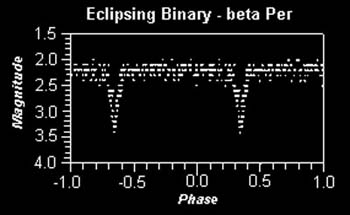
Beta Persei light curve, EA Eclipsing variable prototype. Image: http://www.teleskopy.net/
EB
Beta Lyrae-type eclipsing systems. These are eclipsing systems having ellipsoidal components and light curves for which it is impossible to specify the exact times of onset and end of eclipses because of a continuous change of a system's apparent combined brightness between eclipses; secondary minimum is observed in all cases, its depth usually being considerably smaller than that of the primary minimum; periods are mainly longer than 1 day. The components
generally belong to early spectral types (B-A). Light amplitudes are usually <2 mag in V.
EW
W Ursae Majoris-type eclipsing variables. These are eclipsers with periods shorter than 1 days, consisting of ellipsoidal components almost in contact and having light curves for which it is impossible to specify the exact times of onset and end of eclipses. The depths of the primary and secondary minima are almost equal or differ insignificantly. Light amplitudes are usually <0.8 mag in V. The components generally belong to spectral types F-G and later.
Other classifications of binary systems
D
Detached systems, with components not filling their inner Roche lobes.
SD
Semidetached systems in which the surface of the less massive component is close to its inner Roche lobe.
DM
Detached main-sequence systems. Both components are main-sequence stars and do not fill their inner Roche lobes.
GS
Systems with one or both giant and supergiant components; one of the components may be a main sequence star.
Rotating variable
A star that changes in brightness as it spins around, due to variations in brightness on its surface or to a non-spherical shape. Irregular surface brightness may be due to the presence of large starspots or magnetic effects, as in magnetic variables or oblique rotators.
ACV
Alpha2 Canum Venaticorum variables. These are main-sequence stars with spectral types B8p-A7p and displaying strong magnetic fields.
Spectra show abnormally strong lines of Si, Sr, Cr, and rare earths whose intensities vary with rotation. They exhibit magnetic field and brightness changes (periods of 0.5-160 days or more). The amplitudes of the brightness changes are usually withine 0.01-0.1 mag in V.
ACVO
Rapidly oscillating Alpha2 CVn variables. These are nonradially pulsating, rotating magnetic variables of Ap spectral type (DO Eri). Pulsation periods are in the range of 6-12 mmag (0.004-0.01 days), while amplitudes of light variation caused by the pulsation are about 0.01 mag in V. The pulsational variations are superposed on those caused by rotation.
ELL
Rotating ellipsoidal variables (b Per, Alpha Vir). These are close binary systems with ellipsoidal components, which change combined brightnesses with periods equal to those of orbital motion because of changes in emitting areas toward an observer, but showing no eclipses. Light amplitudes do not exceed 0.1 mag in V.
BY
Draconis star
A type of rotating variable dwarf star, of spectral type G, K or M, that shows quasiperiodic light changes, ranging from a few hundredths to 0.5 magnitude, with a period from a few hours up to 120 days. The variations are due to surface features, such as starspots, passing in and out of view, as the star spins on its axis. Some of these stars also show flares, similar to UV Ceti stars, in which case they belong to both types of variable star. BY Draconis itself is a close binary consisting of a K6V dwarf and a M0V dwarf with an orbital period of 5.9 days and a mean separation of 0.05 AU. The M star exhibits flares that increase its luminosity periodically by a factor of 2 to 4, and also shows smaller variability keyed to its orbit and chromospheric activity.
FK Comae Berenices star
A fast-spinning giant star of spectral type G or K (about as warm or slightly cooler than the Sun but much larger) whose light variations have the same period as the rotation-typically a few days. Changes in brightness of a few tenths of a magnitude are caused by a surface that is more luminous in some areas than others. FK Com stars may represent a late stage in the evolution of common-envelope stars at which the stellar cores have coalesced.
SXARI
SX Arietis-type variables. These are main-sequence B0p-B9p stars with variable-intensity He I and Si III lines and magnetic fields. They are sometimes called helium variables. Periods of light and magnetic field changes (about 1 day) coincide with rotational periods, while amplitudes are approximately 0.1 mag in V. These stars are high-temperature analogs of the ACV variables.
Irregular Variables
I
Poorly studied irregular variables with unknown features of light variations and spectral types. This is a very inhomogeneous group of objects.
IA
Poorly studied irregular variables of early (O-A) spectral type.
LC
Slow irregular variables. The light variations of these stars show no evidence of periodicity, or any periodicity present is very poorly defined and appears only occasionally. Like for the type I, stars are often attributed to this type because of being insufficiently studied.
Many type L variables are really semiregulars or belong to other types.
Irregular variable supergiants of late spectral types having amplitudes of about 1 mag in V (TZ Cas).
LB
Slow irregular variables of late spectral types (K, M, C, S); as a rule, they are giants (CO Cyg). This type is also ascribed, in the GCVS, to slow red irregular variables in the case of unknown spectral types and luminosities.
Other clasifications
S
Unstudied variable stars with rapid light changes
CST
Nonvariable stars, formerly suspected to be variable and hastily designated. Further observations have not confirmed their variability.
Information from:
Combined General Catalogue of Variable Stars (Vol. I-III) (Version of http://www.alcyone.de/SIT/)
Wikipedia, the free encyclopedia
David Darling’s encyclopedia http://www.daviddarling.info/